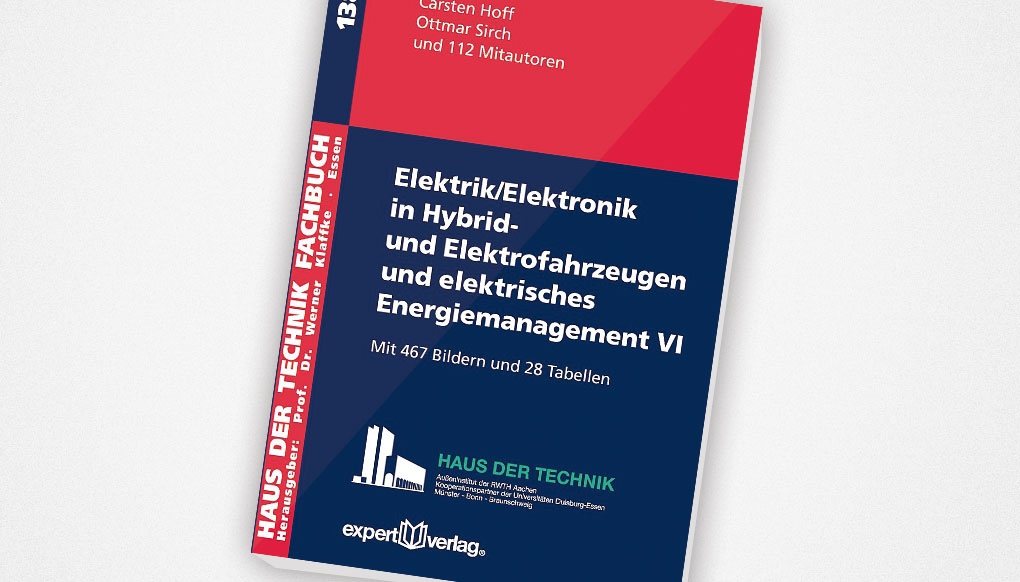edition 2012, Expert Verlag, ISBN 978-3-8169-3114-0
Preface
Climate change is the driving factor behind the transformation in passenger car mobility. The reduction of energy consumption and of carbon dioxide emissions have become important components of future transportation concepts. New mobility con-cepts for urbanization and modified user profiles attract interest all around the world. Electro mobility has become one of the most intensely discussed subjects regarding the future of mobility in mega cities and is increasingly in focus not only in the auto-motive industry but also in the energy sector. According to new research 80% of a city’s population would be interested in using flexible business models for mobility. The premise for purchasing a hybrid or electric vehicle is linked to the expectation that the overall cost of ownership of these vehicles is lower than that of conventional vehicles. Further prerequisites are the sufficient availability of charging points, a sig-nificantly higher range of operation than currently available and comparable stand-ards in terms of comfort and safety. The customers accept higher initial costs, but they expect to break-even due to lower cost of ownership and lower prices for electric energy.
The development activities for hybrid and electric vehicles are increasing continuous-ly. These kinds of cars are presented at every vehicle exposition with new launch dates being continuously announced. Furthermore, concepts for electric power man-agement become more important in terms of efficiency. Automotive electrics/ electronics contribute substantially and offer new potentials for further optimization of fuel or energy consumption, CO2 emissions and operating range.
European CO2 targets are often identified as the key drivers behind the development of hybrid and electric vehicles as well as encouraging the reduction of fuel consump-tion through the use of electrical energy management.
Looking at the issue in its entirety, four important reasons were identified:
- Global targets for CO2 reductions
- Growth markets / emerging nations
- Economical aspects
- Ecological aspects
In addition to the known target of 95g/km of CO2 in the European Union for 2020, there are also binding targets in the United States, China and Japan. The absolute values of the targets are not as aggressive as the European targets, the values being 157g/km, 132g/km and 141g/km respectively. However, the required relative changes of approximately 20% for China, 30% for U.S. and Japan, as well as 40% reduction in Europe are not so different.
In addition to the reduction of emissions in the U.S. and Europe, the topic “avoidance of new emissions in the emerging nations” must be considered. In these markets, the number of residents with a private vehicle will rise significantly each year. Today in Europe, about 50% of the population own a vehicle, whereas in China and India, there are only 1.6% and 0.8% owning a vehicle. Annual growth rates of roughly 10% in both regions are only ecologically viable with significant progress in fleet fuel con-sumption.
Additionally, the available quantity of crude oil must be taken into consideration. The oil production with 30 billion barrels per year has in all probability already reached its peak. As a result of rising demand at constant production rates, Germany’s fuel price is currently experiencing an all-time high; Norway has already passed the milestone of 2 € per liter premium fuel. We don’t expect an end to this trend: The demand especially from emerging markets continues to rise; an increase in oil production is no longer economically possible. Within this context, it is an ongoing discussion how long the oil reserves on Earth will last.
Independent of the availability of raw materials, the trend towards urbanization demands a reduction of emissions in the major conurbation areas, which are growing constantly. In 1975, about 37% of the population lived in urban centers and large cit-ies; today, there are already considerably more than 50%. In the meantime, about 30 mega-cities exist with more than 10 million inhabitants – with the associated prob-lems of pollutant emissions as well as noise issues due to the number of vehicles to be found on the roads.
Which contributions to solve the above-mentioned problems can be achieved with the growing use of fuel-efficient vehicles and hybrid or electric vehicles in the coming years and what changes can be expected?
As mentioned in the introduction, for years now, the number of newly introduced hybrids, plug-in hybrid and electric vehicles has steadily increased. With the Chevro-let Volt and Opel Ampera, an electric vehicle with range extender has come on the market for the first time, whose pure electrical range is sufficient for most people in everyday life and is still suitable for using for a holiday trip. In 2013, as the first OEM, BMW will bring the sub-brand BMW i on the market specifically for electric vehicles and will offer a new kind of visionary mobility. The concepts i3 and i8 have already been published.
In addition to the topics “range” and “safety”, the topic “price reduction and maturity” will be the center of attention for the development of hybrid and electric vehicles in the near future. Many surveys show that only few car buyers are willing to pay a sig-nificant price premium for a hybrid or electric vehicle. Bringing hybrid and electric vehicles in large numbers into the market successfully – without support programs and subsidies – will certainly only succeed if they can be offered at a reasonable price for the buyer while being suitable for everyday life.
At the same time, there are also significant improvements in fuel consumption for conventional vehicles. Features such as the intelligent alternator control and “Stop/ Start” function are now available from all major car manufacturers for their latest models. Just recently, Volkswagen as the first German vehicle manufacturer announced that they will deliver the “Stop/Start” function as standard feature in all new models. “Stop/Start” reduces the fuel consumption in the New European Driving Cycle (NEDC) by typically 0.5 l/100km. The “Coasting” feature, being the next enhancement to the “Stop/Start” function by turning off the engine during coasting, will be the next function to enter the market. Whereas the fuel savings by “Coasting” in the NEDC are still low, the first test vehicles proved that coasting could reduce fuel consumption in typical real world driving conditions by about 0.5l/100km.
We expect to see the dual-voltage electrical system with 48Vund 12V as one of the biggest changes in vehicle’s electrical system in the 2015/16 timeframe. In this con-nection, generator and consumer with a high energy demand such as electric power steering, anti-roll stabilization or cooling fan will be on the 48V-side of the vehicle electric system, while control units and sensors remain on the 12V-side. A larger part of the required electrical energy in the 12V electrical system can be recovered from the kinetic energy, meaning a further reduction in fuel consumption of about 0.5 l/100km can be achieved. As a positive side effect of this partitioning, the voltage stabilization on the 12V-level can be dropped since the dynamic high-power con-sumers are no longer part of the 12V electrical system.
The book in hand was originated as part of the conference “Electric & Electronic Sys-tems in Hybrid and Electric Vehicles and Electrical Energy Management” organized by Haus der Technik e.V. Essen, April 23rd and 24th, 2012, in Miesbach. Subjects and articles about the overall system of electrics/electronics of hybrid and electric vehicles and concepts of electrical energy management are highlighted and discussed in de-tail. Approaches for Hybrid, Plug-In Hybrid and Electric Vehicles as well as E/E archi-tectures, charging systems, power electronics, and low voltage accumulators are covered.
We would like to thank all the authors and speakers whose interesting technical con-tributions supported the publication of this book. Furthermore, we would like to thank Mr. Bernd Hömberg and his staff at Haus der Technik e.V. in Essen for planning and organizing the event, Dr. Arnulf Krais from expert verlag in Renningen for the publish-ing activities and Dr. Vera Lauer, Professor Dr. Ludwig Brabetz, Mr. Friedrich Graf, Professor Dr. Hans-Georg Herzog, Dr. Thorsten Hestermeyer, Dr. Jan Lichtermann, Dr. Marc Nalbach, Dr. Dieter Polenov, Dr. Hartmut Pröbstle, Mr. Tomas Reiter, Pro-fessor Dr. Dirk-Uwe Sauer and Mr. Richard Schöttle for their support in the program committee.
Munich, April 2012 Ottmar Sirch
Dr. Carsten Hoff
OEMs and suppliers are working intensely on new concepts and vehicles. The on-board electrical system will determine the viability of applications both in hybrid settings and in purely electric driving. There are many challenges, but solutions that have proved their efficiency will see the light of the real world. It’s all a matter of perspective. Hybrid vehicles certainly act as trailblazers prior to wider scale adoption of all-electric vehicles. Electric vehicles are still having issues with energy storage so that their wide-spread use is to be expected in the more distant future only. However, technical solutions, just like new concepts and ideas for future powertrains, are being conceived and validated now. German OEMs and suppliers are staking out their fields in an exciting market.
With EEHE, Haus der Technik provides a brilliant opportunity for developers, users and researchers to meet. The event actually combines the three earlier conferences Energy Management & Electrical Systems, Electrics/Electronics in Hybrid and Electric Vehicles and Engine Start/Stop Systems. The conference attendants thus have a chance to meet all important players in the industry at a single conference. Having screened a great number of submissions following the Call for Papers, the programme committee has put together an attractive array of conference papers, poster presentations and vehicle displays.
The topics that will take centre stage in Bamberg on 23 and 24 April 2012 are: electric & electronic systems in hybrid, plug-in hybrid and electric vehicles, electric charging, electric energy management, E/E architectures, start/stop systems, power electronics, low-voltage storage systems, battery management and E/E systems for fuel-cell electric passenger and utility vehicles.
There will also be an exhibition to enhance the conference experience: electric and hybrid vehicles and also test vehicles of leading manufacturers will be on display.


